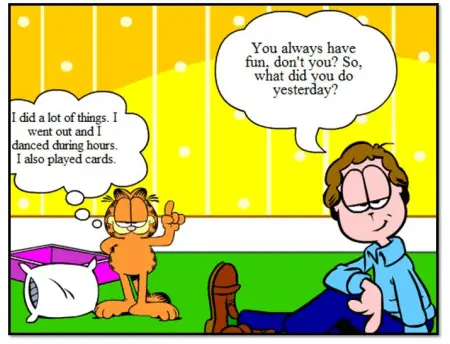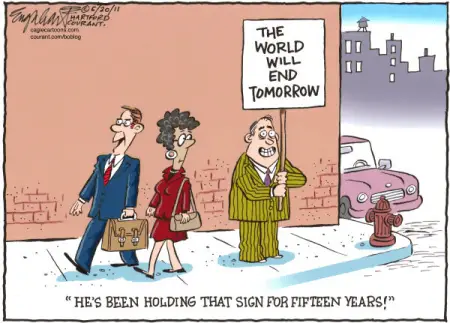Let us take a look at two sample sentences:
- I went to Spain.
- I have gone to Spain.
The first sentence is in the simple past form, while the second sentence is in the present perfect form. Do they have the same meaning? Are they interchangeable? This article will explore the difference between simple past and present perfect.
Summary Table
| Simple Past | Present Perfect |
| Formed by adding “d,” “ed,” or by retaining or changing the spelling of the verb | Formed by adding “has” or “have” to the past participle form of the verb |
| Used to describe an action completed in the past, an action that is finished in someone’s life (i.e. the person is dead), a past action that occurred once, never, or several times in the past; describes a series of actions that happened in the past or an action in the past that occurred in the middle of another action | Used to talk about actions that continue today, actions that stopped recently, and actions that occurred never, once, or many times before; expresses actions that happened in the past but the time is unknown; used to talk about life experiences; answers the question “how long?” and emphasizes the effect or result of a past action |
| Used with finished time words such as “yesterday,” “this morning,” “last night,” “in 1987,” “many years ago,” “in the 17th century,” etc. | Used with words like “for,” “never,” “just,” “not yet,” “until now,” “to this day,” “already,” etc. |
Definitions

The simple past tense, as the name suggests, is the basic form of past tense. It is used to:
- Talk about an action that was completed at a certain point in the past; for example: I talked to Steven four hours ago.
- Describe an action that is finished in someone’s life (i.e. the person is dead); for example: My late grandparents planted mango trees in our backyard.
- Express a past action that occurred once, never, or several times and that was completed in the past; for example: My dad visited his farm every weekend.
- Describe a series of actions that happened in the past; for example: I boarded the plane, hopped in a cab, and went straight to the museum.
- Talk about an action in the past that occurred in the middle of another action; for example: While I was busy reading a book, the cat suddenly jumped on me.
The simple past form is usually accompanied by finished time words or phrases such as “yesterday,” “this morning,” “last night,” “in 1987,” “many years ago,” “in the 17th century,” etc. However, it is important to remember that these are not always necessary. In the simple past form, it is understood that the action was completed at a specific time in the past even when it is not stated.
The following rules apply to form the simple past:
- For regular verbs that end in “e,” simply add “d”; for example: bake – baked, fake – faked
- For regular verbs that end in a consonant sound or other vowels, add “ed”; for example: talk – talked, veto – vetoed
- For some one-syllable regular verbs with a short, stressed vowel, double the last consonant and add “ed”; for example: ban – banned, thin – thinned
- For some regular verbs that end in “y,” change “y” to “i” unless the “y” follows a vowel; for example: worry – worried
- Irregular verbs may change some letters, others retain the same spelling; for example: come – came, take – took, cut – cut

On the other hand, the present perfect tense:
- Describes an action that is still going on; for example: I have known him since I was eleven years old.
- Talks about a life experience; for example: My brother has been to Japan once.
- Expresses an action that occurred recently; for example: I have just placed my order online.
- Talks about an action that occurred once, never, or several times before the time of speaking; for example: I have never been to an amusement park.
- Describes an action that happened in the past and the time is unknown; for example: I have read J.K Rowling’s “Casual Vacancy.”
- Stresses or emphasizes the effect or result of a past action; for example: I have completed college. (In this example, the fact that the speaker graduated is emphasized and not when the event occurred.)
- Talks about a repeated action; for example: I have been to the U.S eight times.
- Answers the question “how long”; for example: I have stayed in Thailand as a volunteer teacher for 7 years.
Words like “for,” “never,” “just,” “not yet,” “until now,” “to this day,” “already,” etc. are the signal words of the present perfect tense.
The following formula is used to form the present perfect tense of the verb:
- have (plural) or has (singular) + past participle of the verb
Here are some examples:
- has/have filed
- has/have found
- has/have eaten
- has/have taken
Simple Past vs Present Perfect
What, then, is the difference between simple past and present perfect?
The most obvious difference between the two is their form. Simple past can be formed by adding “d,” “ed,” or by retaining or changing the spelling of the verb. Present perfect can be formed by adding “has” or “have” to the past participle form of the verb.
Simple past, in general, is used to indicate an action that happened and was completed in the past. It is used to describe an action that is finished in someone’s life (i.e. the person is dead), express a past action that occurred once, never, or several times and that was completed in the past, describe a series of actions that happened in the past, or talk about an action in the past that occurred in the middle of another action. It is usually accompanied by finished time words like “yesterday,” “this morning,” “last week,” etc.
In contrast, present perfect is used to talk about actions that still continue today, actions that stopped recently, or actions that occurred never, once, or many times before the time of speaking. It also describes actions that happened in the past but the time is unknown, or actions that are repeated in the past. Moreover, it can be used to talk about life experiences, answer the question “how long?” and emphasize the effect or result of a past action. It is used with time words like “for,” “never,” “just,” “not yet,” “until now,” etc.





